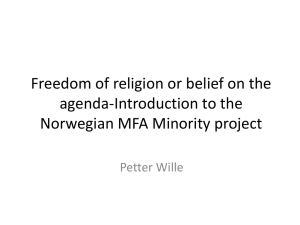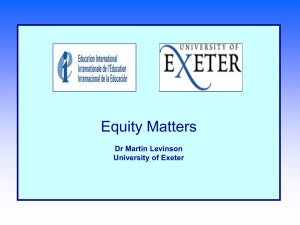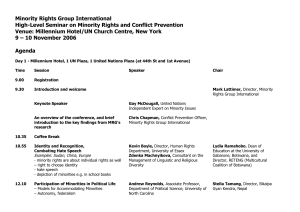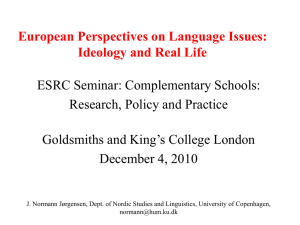LearningMigration - Office of the High Commissioner for Human Rights
advertisement
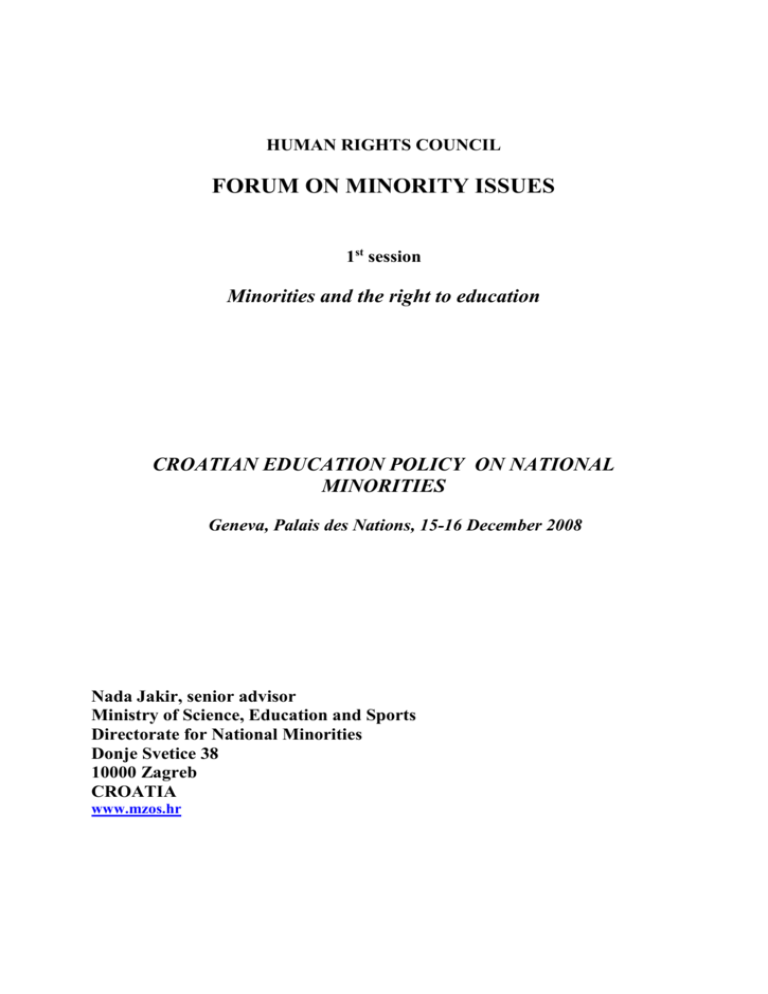
HUMAN RIGHTS COUNCIL FORUM ON MINORITY ISSUES 1st session Minorities and the right to education CROATIAN EDUCATION POLICY ON NATIONAL MINORITIES Geneva, Palais des Nations, 15-16 December 2008 Nada Jakir, senior advisor Ministry of Science, Education and Sports Directorate for National Minorities Donje Svetice 38 10000 Zagreb CROATIA www.mzos.hr 1. Background of minorities in schools Croatian policy on national minorities is based on democratic values developed in relevant United Nations’ instruments for human rights protection which Croatia has ratified, such as the UN International Covenant on Civil and Political Rights, the Universal Declaration of Human Rights, the International Covenant on Economic, Social and Cultural Rights, the UN Convention on the Elimination of All Forms of Discrimination against Women, the Declaration on the Rights of Persons Belonging to National or Ethnic, Religious and Linguistic Minorities. Furthermore, Croatia ratified all the conventions and recommendations of the Council of Europe addressing human rights and has concluded bilateral agreements on protection of national minorities with neighbouring countries. In addition it has put in place a number of relevant legislative provisions, such as the Constitutional Law on the Rights of National Minorities (CLNM), the Law on the Use of Language and Script of National Minorities and the Law on the Education in the Language and Script of National Minorities. The term of national minority is defined in the Article 5 of the Constitutional Law on the Rights of National Minorities. According to that provision, a national minority is a group of Croatian citizens whose members have traditionally inhabited the territory of the Republic of Croatia and whose members have ethnic, linguistic, cultural, and/or religious characteristics that are different from those of other citizens and who wish to preserve these characteristics. The CLNM sets the domestic legal framework for minority rights in Croatia. The national minorities are guaranteed the right of having up to eight representatives in the Parliament, and to be reserved seats on a proportional basis at local government level. The census and any recent electoral registers are used to calculate this allocation. Additionally, the CLNM establishes Councils of National Minorities at local, regional and state level as consultative bodies that provide opinions and proposals on relevant minority issues. According to the last census in 2001 the population of Croatia is 4.437.460 inhabitants. Taking into account the mentioned definition of a national minority, the Croatian society encompasses as it follows: Croats - 3.977.171 (89,63%); Albanians – 15.082 (0,34%); Austrians – 247 (0,01%); Bosniacs 20.755 – 0,47%); Bulgarians – 331 (0.01); Czechs – 10.510 (0,24%); Germans – 2.902 (0,07); Hungarians – 16.596 (0,37%); Italians – 19.636 (0,44%); Jews – 576 (0,01%); Macedonians 4.270 (0,10%); Montenegrins – 4.926 (0,11%); Poles – 567 (0,01%); Roma – 9.463 (0,21%); Romanians – 475 (0,01%); Russians – 906 (0,02%); Ruthenians – 2.337 (0,05); Slovaks – 4.712 (0,11%); Slovenians – 13.173 (0,30%); Serbs – 201.631 (4,54%); Turks – 300 (0,01%); Ukrainians – 1.977 (0,04%); Wlachs – 12 (0,00%); others /related to the listing/ - 21.801 (0,49%); undeclared according to the definition – 89.130 (2,01%); unknown – 17.975 (0,41%). 2. Provisions in schools The national strategy for the area of education entitled the Education Sector Development Plan 2005-2010 was adopted by the Government of the Republic of Croatia in 2005. Within the key priorities in educational development, the national minorities are stated as target group that will be offered the specific educational programs and implemented following the standards of efficiency and quality in education. The persons belonging to national minority can exercise their constitutional right through three basic models and forms of education: model A – overall education in the language and script of a national minority with obvious Croatian language learning; - model B – bilingual education; the curriculum is realised in minority language (humanities and social sciences) and in Croatian language (natural science); 2 - - - model C – nurturing the language and culture of national minority; the additional module of curriculum, 2-5 hours per week, closely related to the culture of national minority (composed of the minority language, literature, history, geography and visual arts and culture); the language of a respective national minority is taught as the language of the community; the pupils at schools in which the tuition is in Croatian language are offered to learn the minority language as well; seminars, workshops in minority languages; summer and winter schools, distance learning; specific programs for Roma population inclusion in educational system according to the comprehensive strategic documents the National Programme for the Roma and the Action Plan for the Decade of Roma Inclusion 2005-2015. 3. Data on national minorities in education Education in the language and script of a national minority is carried out in preschool institutions, primary schools, secondary schools and the other school institutions that hold classes in a language and script of a national minority. The other forms of education like seminars, winter and summer schools, distance learning and the like are provided according to the Law on the Education and Training in the Language and Script of National Minorities. Within the overall education system 10.146 scholars who belong to national minorities in 2007 practised the education right in one of three educational models. Pre-school education School year 2006/2007: Model A: Czechs – 141 children, 5 groups, 2 kinder gardens, 12 educators; Hungarians – 148 children, 8 groups, 8 kinder gardens, 12 educators; Serbs – 391 children, 16 groups, 4 kinder gardens, 27 educators; Italians – 845 children, 39 groups, 18 kinder gardens, 89 educators; Model C: Hungarians – 20 children, 1 group, 1 kinder garden, 1 educator. Primary education School year 2006/2007: Model A: Czechs – 314 students, 3 schools, 36 teachers; Hungarians – 256 students, 5 schools, 71 teachers, 32 classes; Serbs – 2.350 students, 18 schools, 369 teachers, 160 classes; Italians – 1.523 students, 17 schools, 263 teachers, 105 classes; Model B: Hungarians – 14 students, 1 school, 3 teachers, 2 classes.; Model C: Czechs – 452 students, 19 schools, 17 teachers; Hungarians – 729 students, 15 schools, 11 teachers, 87 classes; Slovaks – 510 students, 10 schools, 6 teachers; Serbs – 430 students, 22 schools, 38 teachers, 57 classes; Macedonians – 25 students, 2 schools, 2 teachers, 2 classes; Germans and Austrians – 67 students, 1 school, 7 teachers, 5 classes; Ukrainians – 28 students, 1 schools, 2 classes, 1 teacher; Ruthenians – 48 students, 1 school, 6 classes, 2 teachers. Secondary education School year 2006/2007: Model A: Bosniacs – 94 students, 1 school; Hungarians – 67 students, 1 school, 36 teachers, 10 classes; Serbs – 923 students, 8 schools, 203 teachers, 66 classes; Italians – 775 students, 4 schools, 143 teachers, 66 classes; Model B/ C: Czechs – 52 students, 1 school, 10 teachers, 4 classes. Roma minority inclusion in education system The Action Plan for the Decade of Roma Inclusion 2005-2015 was developed by the Governmental Office for National Minorities and approved by the Government in 2005. It follows the previously adopted strategy entitled the National Program for the Roma, adopted in 2003. The Governmental Office for National Minorities is responsible for the implementation and monitoring of the mentioned strategic documents. 3 The Action Plan further details the National Program for the Roma in 4 areas: education, health care, employment and housing/infrastructure. Education component aims to include Roma children and youth in all level of education system and support them in order to improve their inclusion in society. The programme of pre-school education is intended to encompass as many of Roma children as possible and thus create the precondition for their successful learning in primary school. The Ministry of Science, Education and Sports set-up the network of Roma assistants whose main task is to intermediate between the Roma community and the school in joint efforts for the improvement of education of Roma children in schools and their integration in school environment. Concerning the inclusion of Roma children in education system the improvement has been achieved through different measures: by increasing the number of Roma children enrolled in preschool education, primary and secondary education including the vocational education, by ensuring the scholarships for all Roma students in secondary and tertiary education, by ensuring the fees for those Roma adults who are included in adult education, by ensuring free of charge the accommodation in dormitories for secondary and tertiary Roma scholars, as well as free of charge transport for all primary and secondary Roma scholars, including the Roma students in higher education. Within the overall education system 3.628 scholars who belong to Roma national minority in 2007 were included in education system. The data are relating to those who declared themselves as belonging to Roma minority. 4. Curriculum The Ministry of Science, Education and Sports developed and adopted the new curriculum for primary schools in 2006 which is based on the Education Sector Development Plan 2005-2010 and the Croatian National Education Standard. Among other components the curriculum introduces the new student oriented approach to learning and teaching process in education. The new curriculum in minorities’ languages for primary and secondary education has been in the process of developing for three models (A, B, C) previously mentioned. 137 teachers in minorities’ languages were engaged in working groups and 200 minorities’ teachers participated during the process of curriculum development. 5. Teacher training The Government is responsible for the professional, pedagogic and psychological training of teachers, i.e. their pre-service and in-service training. During 2007/2008 academic year the Teacher Training Agency organised 25 seminars for teachers in the languages of national minorities (11 seminars for teachers in Serbian, 4 in Hungarian, 4 in Italian, 5 in Czechs, 1 in Slovak). Within the Teacher Training Agency there are 6 permanently employed counsellors specialized for offering their services to minorities’ teachers regarding specific issues concerning the education in the minorities’ language. The Ministry of Science, Education and Sports also supports the teacher training programs organised by minority NGOs and training of teachers and their study visits to the country of the respective minority language. 6. Textbooks Ministry of Science, Education and Sports in 2007/2008 and 2008/2009 academic year ensured the textbooks free of charge for all primary school pupils and pupils in first two years of secondary school. The same goes for pupils who belong to national minorities, i.e. who have chosen to be educated in one of three models of education in minorities’ language. The 4 teachers in minorities’ language have chosen the textbooks to be translated in the respective minority language. 96 titles were translated in Italian, Serbian, Hungarian, Czechs and Slovak language. 7. Allocation of resources The Ministry of Science, Education and Sport provides the largest financial support to the education sector, which includes the national minorities’ education as well. The regional/county and the local governments also allocate funds for education. According to the national education strategy, special attention is given to the minorities’ education on the state budget level which include besides regular financing, the means for the textbook development in minorities’ languages, for the implementation of the National Program for the Roma and the Action Plan for the Decade of Roma Inclusion, for distance learning in minorities’ language and culture, the summer and winter schools for minorities, seminars, workshops, NGOs projects realised in partnership with schools and other. 5

